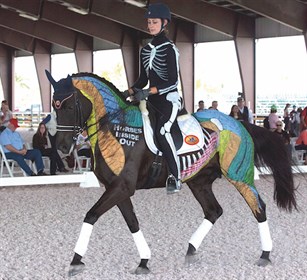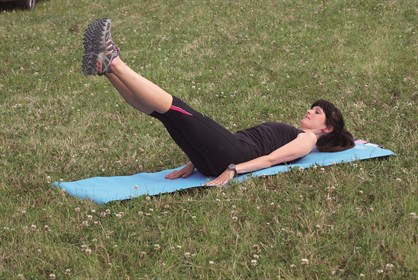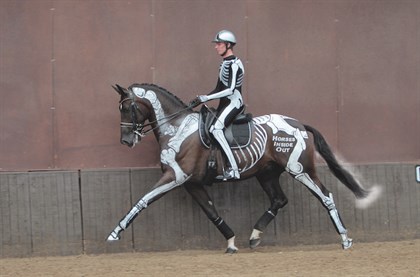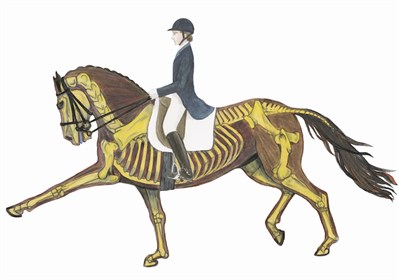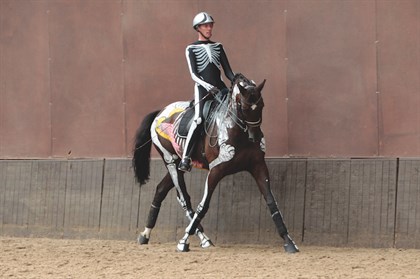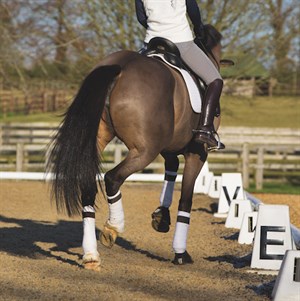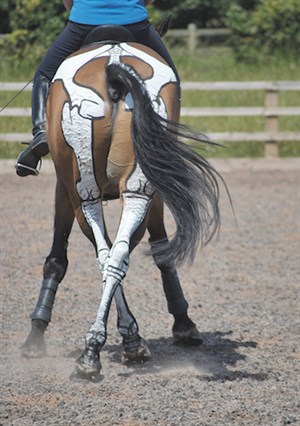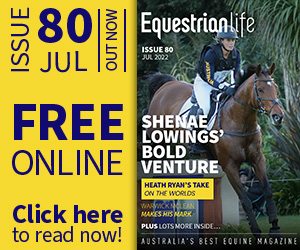
No skeleton, frame or muscular system in either horse or human is completely symmetrical.
Understanding your horse’s anatomy can improve performance and help you realise its potential as well as your own. Gillian Higgins, author of the highly successful books, including “How Your Horse Moves’’, introduces a new way to train.
WORDS BY GILLIAN HIGGINS // PHOTOS SUPPLIED BY EXISLE PUBLISHING
THE FOUNDER OF Horses Inside Out, Gillian Higgins, is a human and equine sports and remedial therapist based in Nottingham, England, and dedicated to equine and rider wellbeing and education. In her new book, “Posture and Performance’’, Gillian has created a rider handbook focussing on the “principles of training horses from the anatomical perspective’’. Here, in selected extracts from her latest work, Gillian shares with us new ways to train and a new way to think, covering topics from symmetry, rider position and practical exercises for you to try.
Symmetry
When considering symmetry in horses we are looking at bilateral musculoskeletal symmetry, where the two sides are the same or very close in size, shape and position. Symmetry of movement is where stride length or performance is the same on both reins. This is the ideal.
Laterality
This refers to left or right-brain dominance. In humans this presents as left or right-handedness. Horses, too, have dominant brain hemispheres. This laterality, which is of little consequence until the horse is ridden, can be seen as a preference for working on the left or right rein. Translated into practical application, some horses are more successful or safer when competing or performing on a right-hand track, some on a left.
Rider asymmetry
Approximately 80 per cent of people are right-handed and left-brain dominant. This means the left side of the body specialises in balance and support, whilst the right side is responsible for motor function. This pattern is continually reinforced by the cellular memory of the muscles and fascia involved in repeated actions, for example, always writing with the right or left hand. All physical activities, whether gymnastics, running, dancing or riding, require specific neuromotor training in order to minimise the inherent asymmetry. In the case of equestrian sport, asymmetry is further complicated as it involves interaction between horse and rider. By visiting a physiotherapist it is possible to identify and assess myofascial imbalances, recognise asymmetries and, with repeated exercises, improve posture and redress faulty movement patterns. Horses do not have this ability, so it is up to us, as their personal trainers, to devise a programme to minimise both our own and our horses’ asymmetries.
Stretching and strengthening exercises for horses and Pilates, yoga or the Alexander Technique are a good tarting point for correcting asymmetry.
Seat aids
Effective use of the seat is one of the more difficult aids to achieve. The rider must first learn to relax, align his centre of gravity with that of the horse, recruit the core muscles and sit perfectly still without bouncing or interfering with the movement. When the rider is asymmetrical he may use the weight of his head, arms or legs inappropriately to stabilise his position. This will in turn affect the horse’s balance, posture and performance. Achieving a balanced seat allows riders to develop independent hands, good riding posture and supple legs. As the horse learns to respond to the subtle changes of the seat, communication becomes invisible.
Horse asymmetry
As with a near-symmetrical rider, a near-symmetrical horse is more likely to be straight, move efficiently and correctly, expend a minimum amount of energy and distribute his weight evenly. Conversely, an asymmetrical horse will exhibit uneven wear and tear through the limbs and body, uneven gaits and eventually varying degrees of lameness. Asymmetry can be congenital or as a result of trauma, conditioning, uneven muscle development, conformational discrepancies or lameness. It can be exacerbated by always pulling hay from a haynet in the same direction, being led, saddled or mounted from the same side or by working more on one rein than the other when schooling. Horses will always move in the way that is most comfortable and easiest for them. Asymmetry is often exacerbated by repeatedly, generally unintentionally, strengthening the already strong muscles and weakening the weak.
This results, often from an early age in:
• Uneven conditioning of muscle tone and body mass
• Uneven development of the musculoskeletal system
• Asymmetrical movement patterns
Asymmetry manifests itself in:
• Imbalanced musculature
• Unequal pushing from behind
• Uneven hind limb protraction
• Reduced range of movement and difficulty bending in one direction
• Consistently falling out through one shoulder
• A preference for working on one rein
• A preferred canter lead or favoured landing limb from a jump
• Working on three tracks as opposed to two
Assessing straightness and symmetry during movement is as important as the static assessment. A qualified practitioner can identify the movement patterns that we would like to change and the factors that are interfering with the movement we would like to achieve.
Straightness
Once we recognise and accept a degree of asymmetry present in our horse we can take action to counter its effects. By training the muscles and straightening him it is possible to achieve optimum movement, posture and performance. A straightened horse will be physically and mentally in balance, muscularly and symmetrically fit, supple, strong, able to round the back and carry the rider with ease.
Straightness refers to the muscular symmetry and even development of the horse from side to side. When the horse is straight, that is when his longitudinal axis is aligned with and can follow a straight or curved track and when he can bend or flex equally on either rein, performance will be maximised. Regardless of activity, stage of training and head position, whether we are asking for a free or collected walk, leg-yield or advanced dressage movements, weight will be transferred equally, the hind legs will push in the direction of the centre of mass, and wear and tear on the joints will be minimised.
A straightened horse will be physically and mentally in balance.
How to assess asymmetry
This simple 20-point checklist of physical indicators can be used to assess symmetry. When standing square on a flat firm surface ask:
1. Are the false hips (tuber coxae) level?
2. Is the jumper’s bump (tuber sacrale) horizontal?
3. Are the hindquarters equally muscled?
4. Are the point of buttocks (tuber ischia) the same height?
5. Is the tail centred or is it carried to one side?
6. Is the spine straight from tail to ears?
7. Are the ears level?
8. Are the withers and tops of scapulae equal on both sides?
9. Is the back musculature the same on the left and right sides?
10. Are the thighs equally muscled?
11. Are the hocks level?
12. Are the chest (pectoral) muscles equal?
13. Are the muscles at the base of the neck and shoulder the same left to right?
14. Are the points of shoulder level?
15. Are the forelegs equally muscled?
16. Are the hooves the same shape and the hoof pastern axis the same angle left to right?
17. Are the hooves worn evenly?
18. Are the fetlocks symmetrical?
19. Is the barrel of the ribs equal on both sides?
20. Is the head and neck the same shape on both sides?
Positioning of the head and neck
To ensure efficient movement with free, regular gaits, the horse must be permitted to carry his head in a relaxed, comfortable manner without restriction. Understanding how the horse uses positioning of the head and neck to affect the back via the spinal ligament system is probably the most important factor in achieving a balanced, well-adjusted horse. It also influences all other aspects of movement and performance both physically and psychologically. Understanding the structure and function of the neck helps us to train with empathy and select suitable exercises and an appropriate neck outline for age, muscle condition and stage of training.
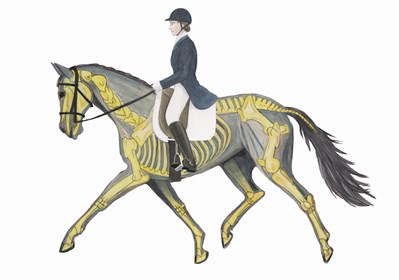
The above two images show how positioning of the head and neck can affect hind limb movement.
Hyperflexed neck position
The leverage created in this position is often painful for the horse and puts an unacceptable amount of pressure on the small atlanto-occipital joint. Any disruption to the mechanics of this joint can affect the posture of the entire spine. It is used by insensitive riders wanting complete submission from their horse.
Disadvantages include:
• Tension, strain and potential damage to the nuchal ligament particularly in the upper cervical region
• A severely restricted windpipe
• Crushing of the soft tissue structures on the underside of the neck
• Pressure on the bars of the mouth
• Restriction in circulation to the tongue
• Excessive recruitment and shortening of the scalene, longus colli, brachiocephalic, sternomandibular and some of the thoracic sling muscles
• Constricted intervertebral foramina (spaces through which the spinal nerves exit from the spinal cord) potentially affecting neuromuscular control
• Reduction of weight carried on the hindquarters, making the horse heavy on the forehand
• Prevention of true collection by restricting the ability to step under, causing the hocks to trail
• Reduced hindlimb protraction
• Restricted vision
How horses collect
Developing collection is progressive relative to age, stage, level of training and musculoskeletal strength. During collection, as the centre of mass moves backwards, steps shorten as there is a reduction in the retraction of the hindlimbs. The quarters lower to carry more weight as flexion in the joints, and ideally in the back and lumbosacral junction increases. It is this flexion in the haunches which provides upward thrust and spring.
Flexion in the haunches requires muscular strength and a high degree of eccentric and isometric muscular contraction, particularly in the extensor chain. The back is supported by well-conditioned core muscles with the abdominal muscles, particularly the rectus and external oblique, pressing upon the visceral contents of the abdomen. This contributes to the horse working with good posture. As more weight is carried behind, the forelimb is lightened, the base of the neck retracts and the head and neck come up. This lightens the forehand, makes the horse look and feel more uphill and gives more freedom and expression to the forelegs.
Applying the science
Riding a well-trained, laterally supple and willing horse is a pleasure. Riding turns, loops, circles, figures of eight and serpentines, which can all be combined to produce an infinite number of bending exercises, will improve the skills of both horse and rider. In order to enjoy a flexible, well-balanced horse able to bend equally to both sides it is important that the rider’s hands reflect the movement of the neck muscles, the outside rein lengthens and the rider looks in the direction of the bend. Sitting tall and still, keeping the rider’s centre of gravity above that of the horse, and applying the aids in conjunction with the horse’s rib movement, will contribute to the feeling of the horse bending round the inside leg and will give the rider the pleasure and experience of the feeling of being at one with their horse.
Circles
Riding a circle accurately in walk, trot or canter is one of the most difficult movements for horse and rider to achieve. It requires well-established lateral suppleness, balance, control, core strength, collection, accuracy and perseverance. ?Circles require the inside hind leg to come under the body whilst tracking up, keeping the head level, maintaining balance, suppleness, uniformity of bend, impulsion and rhythm. The smaller the circle the greater the degree of collection, balance and impulsion required.
Leg-yield
Performed on two tracks, leg-yield is a fundamental, versatile, suppling exercise in which the fore and hind limbs adduct and abduct to move the horse sideways whilst the spine is laterally flexed away from the direction of travel. This mobilises the ribs, back and hips, activates the deep vertebral muscles and is a useful contributory factor in developing longitudinal and lateral flexibility. Leg-yield forms a solid foundation for all lateral work and should be mastered before progressing to more advanced lateral movements.
Shoulder-in
Shoulder-in and shoulder-fore, which requires about half the angle of shoulder-in, are natural progressions from leg-yield and are good exercises for suppling and developing straightness, symmetry and strength. Shoulder-in, which improves forelimb expression and shoulder mobility, improves engagement of the inside hind limb and is an excellent preparatory exercise for collection. It strengthens the forehand adductor and abductor muscles and improves suppleness by inducing spinal rotation and lateral flexion within the back, particularly the cranial thoracic region.
Shoulder-in and shoulder-fore, which requires about half the angle of shoulder-in, are natural progressions from leg-yield.
Travers
Travers is a lateral exercise in which the horse travels on four tracks with the body bent towards the direction of travel and the quarters on the inner track. The movement, which comes mainly from adduction and abduction of the hind limb and lateral flexion and rotation within the caudal thoracic and lumbar regions of the spine, is good for overall suppleness, strengthening and engagement of the hindquarters.
Travers is a lateral exercise in which the horse travels on four tracks with the body bent towards the direction of travel and the quarters on the inner track.
Travers is particularly good for developing elasticity, reach and freedom of hind limb movement, lateral bend, suppleness and as a preparatory exercise for collection and progression to half-pass.
Half-pass
Half-pass is a progression from travers which can be ridden in walk, trot or canter. It is a movement in which the hind leg comes well under the body as the horse is ridden forwards and sideways on a diagonal line with body parallel to the arena wall. During this movement as both forelimbs abduct, both hind limbs adduct or as both hind limbs abduct the forelimbs adduct. Half-pass is the most demanding of all lateral movements; it requires the horse to maintain balance, rhythm and impulsion and differs from leg-yield in that the body is bent towards the direction of travel. A successful half-pass is dependent on the degree and control of elongation of the gluteal and longissimus muscle groups on the outside of the bend.
Half pass in the trot.
Gillian Higgins’ “Posture and Performance’ is available from www.exislepublishing.com.au and leading bookstores.
READ THE LATEST NEWS ARTICLES HERE
https://www.equestrianlife.com.au/articles/Posture-and-Performance
